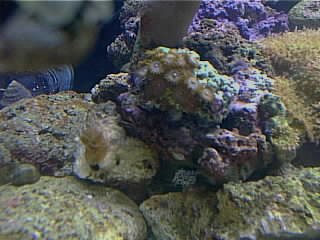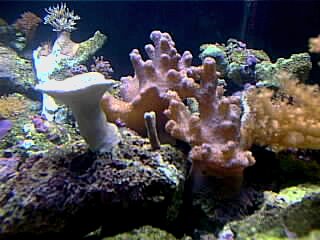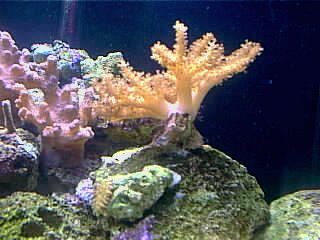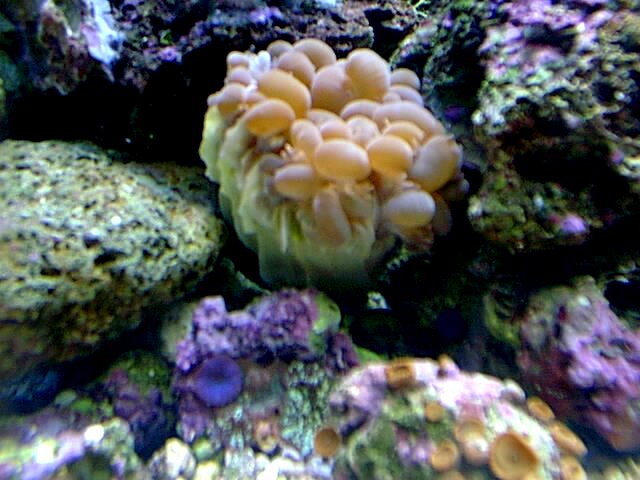
Hello and welcome to The Coral Guy’s Reef
Inhabitants Page. Below are pictures of just some of the reef inhabitants in my aquariums
along with both their common and scientific names. Currently, I am adding only Reef Plus
(Seachem) and B-Ionic (ESV) to my aquarium per the companies instructions. For my make up
water I am using a water dionizer by Aquarium Pharmaceuticals.
All of the corals listed on this page
I have successfully been able to propagate. If you would like information on how to
propagate these and many other corals, you can either refer to my Propagation Page
or send me off a quick note and I will explain the process to you in detail.

| This is a picture of some of my blue
Zoanthis that I am keeping within my 37 gallon reef aquarium. This species is hardy, a
fast grower, and very easy to propagate (what else could you ask for in a coral. |

|
They
require a moderate amount of light and medium water current. Eventually, these Zoanthids
will cover the entire reef plug and start to spread onto the rock. I glued the reef plug
to the rock using super glue reef gel. Aquastick adhesive will also work.
| This is a picture of one of my leather
corals commonly referred to as a Finger Leather Coral. This coral requires a moderate
amount of light and strong water current. I placed this coral directly in the path of the
water being pumped from one of my power heads to ensure enough water movement. When happy,
this coral extends its polyps about ½ inch. |

|
Periodically, this coral (along with many other leather corals) will stop
extending its polyps and appear as if it’s dying. Most of the time, this is not the
case. The coral will remain in this state for about a week and will shead a thin coat of
what looks like skin,. Once the skin has been shed, the coral will again extend it’s
polyps. This coral is easy tp propagate. For more information on how to propagate this and
many other corals, please refer to my Propagation Page
| This is a picture of another one of
my leather corals commonly referred to as a colt coral. This coral requires a moderate
amount of light and moderate water current. This coral is a nice addition to any aquarium.
|

|
This coral grows very fast and is easy to propagate. To propagate this coral, I cut a
branch off of the stalk and place it in a small plastic bowl with small sea shells on the
bottom. Within a couple of weeks, the frag will attach itself to one of the shells. I will
then glue the shell to one of my rocks using either super glue gel or aquastick adhesive.
When placing any frag into a small plastic bowl for
propagation, make sure that the coral is still receiving the proper amount of water
current. To ensure this, I place the bowl in the direct path of the water being pumped
from one of my powerheads and tilt the bowl slightly. Also, make sure that the coral is
still receiving the proper amount of light while in the bowl.
| This is a picture of one of my pulsing
xenia. I have several variations and colors of this species within my reef aquariums.
Xenia require stong light and water movement. Xenia is a very easy species to propagate.
|

|
It is ok to remove this coral from the aquarium when propagating. I recommend that you so
because I’ve heard from more than one hobbyist that xenia expel a chemical when
propagating them that if not washed off of the stalk and the frag will cause harm to your
other corals. Xenia are very
sensitive to the temperature of the water. Make sure that the temperature of your aquarium
is between 76 to 80 degrees if you chose to keep this species. I’ve heard stories of
xenia “Crashing” once the temperature of the aquarium reached 82 degrees. Be
extremely conscious of the water temperature in you aquarium during the summer months. If
necessary, add a chiller to the aquarium to prevent your water temperature from
increasing. You can make an inexpensive chiller yourself using an old dorm refrigerator.
To learn how to do so, please refer to my Do it Yourself page.
| This is a picture of some of the star
polys within my 37 gallon reef aquarium. This species is a nice additon to any aquarium.
This species requires low to moderate amout of light and medium water movement. |

|
The colors
of these star polyps are green, yellow, and brown. This species is very easy to propagate.
To do so, take a sharp razor blade and cut the purple skin into strips and carefully
remove the strips from the rock. Glue the strips to other pieces of rock using super glue
gel. Eventually, the entire rock will be covered with star polys.
Very soon, I am going to cut a strip of brown, yellow, and
green star polys and glue them onto the same rock creating a tri-colored star polyp rock.
This is the true beauty of being able to propagate corals. You can create rocks covered
with variations of species that would be virtually impossible to find in the wild.
| This is a picture of some of the green
hairy mushrooms within my 37 gallon reef aquarium. They require a moderate amount of light
and water movement. These mushrooms are a nice addition to any reef aquarium. They grow
very fast and are extremely hardy. I use the plastic bowl method to propagate this
species. |

|
Frequently, this species will create it’s own babies. I use a sharp
razorblade or pair of sizzors to cut frags off of the mother colony. When fragging the
mother colony, the coral will expel something that looks a lot like dental floss.
Don’t worry, this “dental floss” will not harm any of your corals or fish
(at least, it has never harmed any of my species). Be careful not to place this species next to corals that do not grow
upward (such as star polyps). This species will grow and eventually smother out certain
corals that surround it.
| This is a picture of the bubble coral
in my 37 gallon reef aquarium. It is a rather hardy coral, requires relatively low light
and medium water current. It seems to really like when I feed my fish spiuralina. The
bubbles really start to expand and it has small tenticles that extend and move about. |

|
I have heard about people propagating this coral although I
have not found any approach towards doing so. If you know how to propagate this coral,
please let me know. I have also read that on occasion, this coral releases several eggs
into the aquarium although I have not seen this happen with this coral yet. If you have
had a bubble coral that released eggs, please let me know what happend with the eggs (if
the grew into small corals, died off, etc.). Your feedback on bubble coral propagation
would be greatly appreciated.

| This is a picture of the Yellow Tang
in my aquarium. I have had it now for about 7 months and this guy is doing great. I mostly
feed him seaweed and he absolutely loves it. It keeps him nice and fat. It also helps to
keep his vibrant corals. His color is so intense that he almost seems to glow when under
my power compact lighting. |

|
He has not been an aggressive fish for me. He is rather large for my 37 gallon
aquarium however, he has never knocked over a coral on me. When he swims, he appears as if
to be making a conscious effort not to do so. He is a rather shy fisk. He will spend about
half of his time hiding behind rocks and the other half swimming around the aquarium
searching for seaweed.
| This is a picture of my seabae clown.
I’ve had this fish for about 1 ½ years and he still continues to thrive in my
aquarium. Some hobbyists feel that you need a host anemone in order to keep this fish
alive for an extended period oft time. I have found that this is not the case. You can
keep a seabae (or any other type of anemone fish for that matter) in an aquarium for an
extended period of time without a host anemone. |

|
Clown fish are a great addition to any aquarium. They
are docile and extremely hardy. I do not have a host anemone for this fish because I have
read in several publications that they are extremely hard to keep for an extended period
of time. I am thinking about adding a host anemone and taking on the challenge because I
think that it is so neat to see these fish play within the anemone.

| This is a picture of one of the hermit
crabs within my 60 gallon reef aquarium. I purchased several of these hermits along with
several different types of snails from G.A.R.F . The
refer to the hermit/snail packages that they sell as Reef Janitors. |

|
These guys do an
extremely good job of getting rid of proble algae. G.A.R.F has different Reef Janitor packages based on the type of alge
that is growing within your aquarium. In my case, I had an extremely bad diatom algae
bloom (typical for a recently established aquarium).
| This is a picture of one of the diatom
algae eating snails that goes to work within my 60 gallon reef aquarium. These guys are
extremely efficient. |

|
I rarely have to ever clean the inside of my tank walls. They also
clean the heck out of my live Aragorock. Once placing these guys within your aquarium, they immediately go to work
cleaning your aquarium. I could not believe how fast they cleared up my diatom algae
problem.
Please e-mail me your comments/feedback on this site
joesreef@yahoo.com















